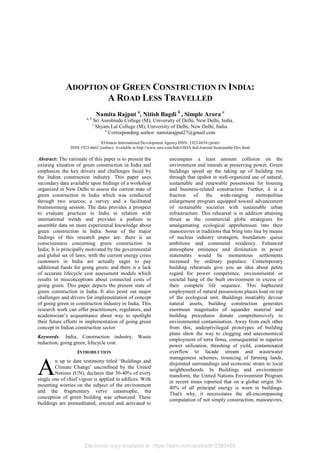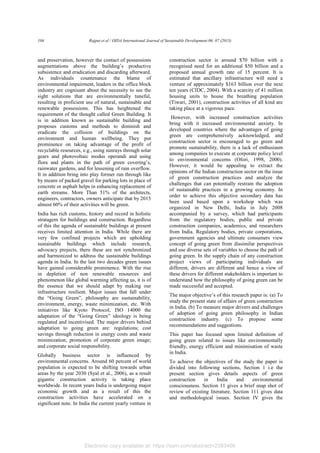1) The document discusses the adoption of green construction practices in India, which is still developing. It analyzes data from a workshop on green construction in India that identified key drivers and challenges through a survey and discussion.
2) Major findings include growing environmental awareness in India, but green construction is mainly driven by government regulations and laws rather than voluntary adoption. Customers are willing to pay more for green buildings due to energy costs.
3) There is a lack of accurate lifecycle cost assessment models, which leads to misunderstandings about the actual costs of green construction. The paper outlines the current state of green building in India and areas that need further focus to promote sustainability in the construction industry.






![Rajput et al / OIDA International Journal of Sustainable Development 06: 07 (2013) 109
proposed for prevention, reuse and recycling of
wastes; (d) Material handling procedures; and (e)
Proposals for education of workforce and plan
diffusion programme. (f) Construction & Demolition
Waste Management Plans need not to be complex
documents and should focus on those reasonable
measures that can be engaged to perk up the
management of construction and demolition waste
within projects. (g) They can also be made available
as a reserve to contractors and subcontractors who
may have been required by both specification and
contractual requirements to get ready Construction &
Demolition Waste Management Plans. (h) Designers
and Developers shall have gaze at the parliamentary
prerequisites in terms of waste permits. (i) The
effectiveness of the construction and demolition
Waste Management ideology and its implementation
should be trailed through customary checks and
audits approved out on site, which should centre on
material contributions to the project and the waste
outputs for each element of plan. (j) The audits
should also investigate into the operational factors
and management policies that contribute to the
generation of waste and recognize appropriate
corrective actions. (k) It is indispensable that
reassessment of waste management practices should
take place all the way through each stage of the
project. (l) The construction & demolition waste
management plan should article proposals for the
management of C&D waste in a few words as
possible. For simplicity, C&D Waste Management
Plan should be prearranged methodically.
SUMMARY AND CONCLUSIONS
This piece of writing is an attempt to identify the
various sources of construction and demolition waste
to develop the strategies for reduction in wastes and
tries to eliminate the hindrances that can slow down
the pace of improvement in reduction of construction
and demolition waste strategies. Socially it would be
a great help for the strategists and policy makers to
know the ground realities of implementing green
construction concept that is still in its infancy in
India. The results would also help deepen industry
practitioners’ understanding about these ground
realities of construction and demolition waste
management in India to enable them to develop
policies to be designed on the desired lines so that
construction and demolition waste management
practices can be implemented smoothly to reap their
full potential.
REFERENCES
[1] Bartlett, E. and Howard, N. (2000), “Informing
the decision makers on the cost and value of
green building”, Building Research and
Information, Vol. 28 Nos 5/6, pp. 315-24.
[2] CIDC (2004), Construction Industry
Development Council, India, available at:
www.cidc.in
[3] Dainty, A.R.J. and Brooke, R.J. (2004),
“Towards improved construction waste
minimisation: a need for improved supply chain
integration?”, Structural Survey, Vol. 22 No. 1,
pp. 20-9.
[4] Ofori, G. (1998), “Sustainable construction:
principles and a framework for attainment –
comment”, Construction Management and
Economics, Vol. 16, pp. 141-5.
[5] Ofori, G. (2000), “Greening the construction
supply chain in Singapore”, European Journal of
Purchasing & Supply Management, Vol. 6, pp.
195-206.
[6] Pasquire, C. (1999),“The implications of
environmental issues on UK construction
management”, Engineering Construction and
Architecture Management, Vol. 6 No. 3, pp. 276-
86.
[7] Revell, A. and Blackburn, R. (2007),“The
business case for sustainability? An examination
of small firms in the UK’s construction and
restaurant sectors”,Business Strategy and the
Environment, Vol. 16 No. 6, pp. 404-20.
[8] Sarkis, J. (1998), “Evaluating environmentally
conscious business practices”, European Journal
of Operations Research, Vol. 107 No. 2, pp. 159-
74.
[9] Syal, M., Hastak, M., Mullens, M. and Sweany,
A. (2006),“United States-India collaborative
research directions in urban housing and
supporting infrastructure”, Journal of
Architecture Engineering, Vol. 12 No. 44, pp.
163-7.
[10]Tiwari, P. (2001),“Energy efficiency and
building construction in India”, Building and
Environment, Vol. 36, pp. 1127-35.
[11]Unruh, G.C. (2008), “The biosphere rules”,
Harvard Business Review, February, pp. 111-6.
[12]Walton, S.V., Handfield, R.B. and Melnyk, S.A.
(1998), “The green supply chain: integrating
suppliers into environmental management
process”, International Journal of Purchasing &
Materials Management, Spring, pp. 1-10.
[13]Further reading Briscoe, G. and Dainty, A.
(2005), “Construction supply chain integration:
an elusive goal?”, Supply Chain Management:
An International Journal, Vol. 10 No. 4, pp. 319-
26.
Electronic copy available at: https://ssrn.com/abstract=2383466](https://image.slidesharecdn.com/ssrn-id2383466-231011093728-f7fc4c84/85/Green-Management-pdf-7-320.jpg)
